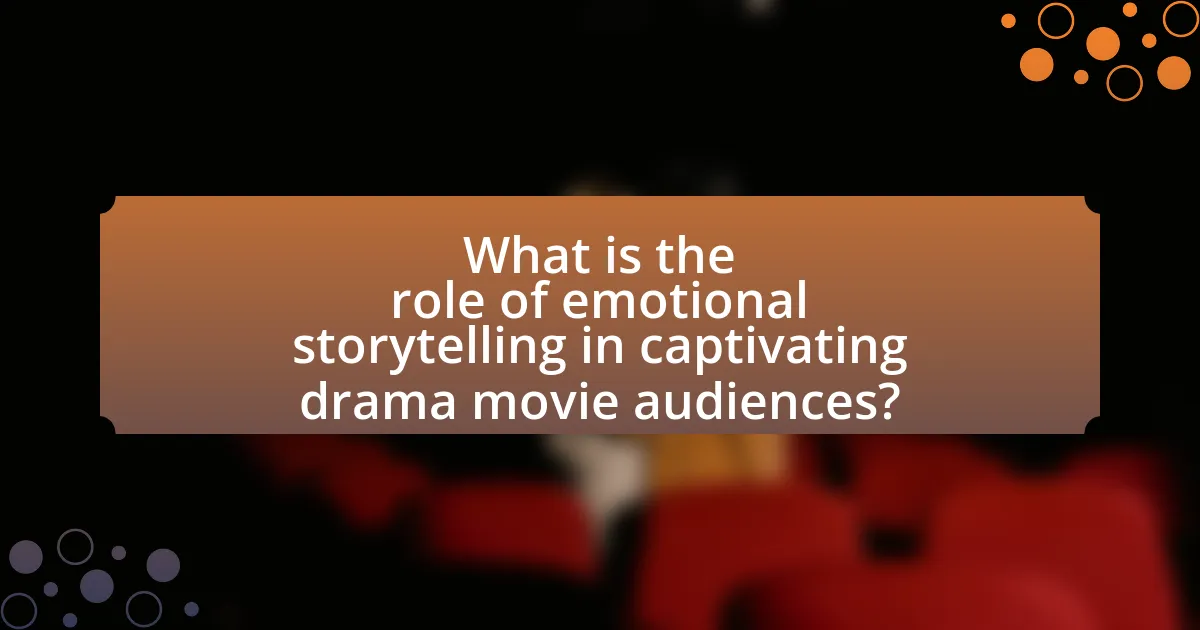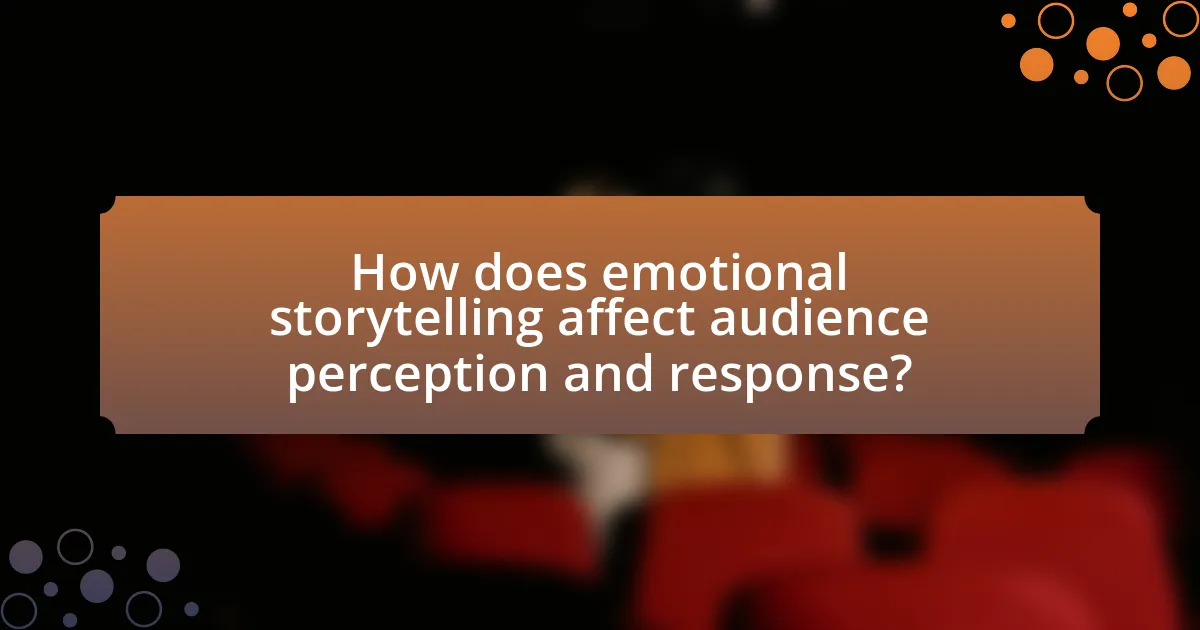Emotional storytelling is a fundamental aspect of captivating drama movie audiences, as it fosters deep connections between viewers and characters, enhancing engagement and retention. The article explores how emotional narratives activate psychological mechanisms such as empathy and narrative transportation, leading to a more immersive viewing experience. Key elements of emotional storytelling, including character development, conflict, and pacing, are examined, along with techniques that filmmakers can employ to evoke genuine emotions. Additionally, the article addresses the challenges of implementing emotional storytelling and offers best practices for creating authentic and impactful narratives that resonate with audiences.

What is the role of emotional storytelling in captivating drama movie audiences?
Emotional storytelling plays a crucial role in captivating drama movie audiences by fostering deep connections between viewers and characters. This connection enhances audience engagement, as emotionally charged narratives evoke empathy and personal reflection, making the viewing experience more immersive. Research indicates that films with strong emotional arcs can significantly impact audience retention and satisfaction, as evidenced by a study published in the Journal of Media Psychology, which found that emotional engagement correlates with higher viewer ratings and repeat viewership. Thus, emotional storytelling is essential for creating memorable and impactful drama films that resonate with audiences.
How does emotional storytelling influence audience engagement?
Emotional storytelling significantly enhances audience engagement by creating a deeper connection between the narrative and the viewer. When stories evoke emotions such as joy, sadness, or empathy, they activate the brain’s emotional centers, leading to increased attention and retention. Research indicates that emotionally charged narratives can improve memory recall by up to 65%, as demonstrated in studies published in the journal “Cognitive Science.” This heightened emotional involvement encourages viewers to invest more in the characters and plot, ultimately resulting in a more immersive viewing experience.
What psychological mechanisms are activated by emotional storytelling?
Emotional storytelling activates several psychological mechanisms, including empathy, emotional resonance, and narrative transportation. Empathy allows audiences to connect with characters on a personal level, fostering a sense of shared experience and understanding. Emotional resonance occurs when the audience feels the emotions portrayed in the story, enhancing their engagement and investment in the narrative. Narrative transportation refers to the immersive experience where viewers become absorbed in the story, leading to altered perceptions and attitudes. Research by Green and Brock (2000) in “The Role of Transportation in the Persuasiveness of Public Narratives” demonstrates that narrative transportation significantly influences beliefs and attitudes, validating the impact of these psychological mechanisms in emotional storytelling.
How do emotions enhance the viewer’s connection to characters?
Emotions enhance the viewer’s connection to characters by fostering empathy and relatability. When characters express genuine emotions, viewers are more likely to identify with their experiences, leading to a deeper emotional investment in the narrative. Research indicates that emotional storytelling activates brain regions associated with empathy, such as the anterior insula and anterior cingulate cortex, which are crucial for understanding others’ feelings. This neurological response reinforces the bond between the viewer and the character, making the story more impactful and memorable.
Why is emotional storytelling essential in drama movies?
Emotional storytelling is essential in drama movies because it fosters a deep connection between the audience and the characters, enhancing viewer engagement. This connection allows audiences to empathize with the characters’ struggles and triumphs, making the narrative more impactful. Research indicates that films that evoke strong emotional responses can lead to increased viewer retention and satisfaction, as demonstrated by a study published in the Journal of Media Psychology, which found that emotionally charged scenes significantly enhance audience recall and emotional investment. Thus, emotional storytelling is a critical component in creating memorable and resonant drama films.
What are the key elements of emotional storytelling in film?
The key elements of emotional storytelling in film include character development, conflict, emotional arcs, and visual storytelling. Character development allows audiences to connect with protagonists on a personal level, fostering empathy and investment in their journeys. Conflict creates tension and drives the narrative, making emotional stakes more pronounced. Emotional arcs illustrate characters’ growth or decline, enhancing the audience’s emotional engagement. Visual storytelling, through cinematography and mise-en-scène, reinforces emotional themes and can evoke feelings without dialogue. These elements work together to create a compelling emotional experience, as evidenced by films like “The Pursuit of Happyness,” which effectively utilizes these components to resonate deeply with viewers.
How does emotional storytelling differentiate drama movies from other genres?
Emotional storytelling differentiates drama movies from other genres by prioritizing character development and emotional depth over action or spectacle. In drama films, narratives often focus on complex human experiences, relationships, and moral dilemmas, which evoke strong emotional responses from the audience. For instance, films like “The Pursuit of Happyness” and “A Beautiful Mind” illustrate profound personal struggles, allowing viewers to connect with the characters on a deeper level. This emphasis on emotional resonance is less prevalent in genres such as action or comedy, where plot-driven elements and humor often take precedence. The unique focus on emotional storytelling in drama films fosters empathy and reflection, making them distinct in their ability to engage audiences through relatable human experiences.

What techniques are used in emotional storytelling for drama films?
Emotional storytelling in drama films employs techniques such as character development, conflict, and visual symbolism. Character development allows audiences to connect with protagonists through relatable emotions and experiences, enhancing empathy. Conflict creates tension and drives the narrative, often reflecting internal struggles that resonate with viewers. Visual symbolism, including color palettes and imagery, reinforces emotional themes, making the story more impactful. These techniques are supported by research indicating that well-developed characters and relatable conflicts significantly increase audience engagement and emotional response, as demonstrated in studies on narrative psychology.
How do filmmakers evoke emotions through narrative structure?
Filmmakers evoke emotions through narrative structure by carefully crafting the sequence and pacing of events to create tension, empathy, and catharsis. For instance, the use of nonlinear storytelling can enhance emotional impact by revealing character backstories at pivotal moments, allowing audiences to connect deeply with characters’ motivations and struggles. Additionally, the classic three-act structure—setup, confrontation, and resolution—guides viewers through emotional highs and lows, facilitating a journey that resonates on a personal level. Research indicates that narratives that incorporate conflict and resolution effectively engage viewers’ emotions, as seen in films like “The Shawshank Redemption,” where the protagonist’s journey from despair to hope elicits strong emotional responses.
What role do plot twists play in emotional storytelling?
Plot twists serve as pivotal elements in emotional storytelling by enhancing surprise and deepening audience engagement. They disrupt the expected narrative flow, prompting viewers to reevaluate characters and events, which can lead to heightened emotional responses. For instance, a study published in the journal “Psychological Science” by researchers at the University of California found that unexpected plot developments can significantly increase emotional arousal and investment in the story. This mechanism not only maintains interest but also fosters a more profound connection to the characters, as audiences experience a range of emotions from shock to empathy. Thus, plot twists are essential for creating memorable and impactful emotional experiences in storytelling.
How does pacing affect emotional impact in drama movies?
Pacing significantly influences the emotional impact in drama movies by controlling the rhythm and timing of narrative events. When pacing is carefully managed, it allows for moments of tension to build, creating anticipation and emotional engagement; for instance, a slower pace can enhance the weight of dramatic scenes, allowing audiences to fully absorb the characters’ emotions and conflicts. Conversely, a rapid pace can evoke feelings of urgency and excitement, but may risk overshadowing deeper emotional connections. Research indicates that films with varied pacing, such as “The Shawshank Redemption,” effectively balance slow and fast sequences to maximize emotional resonance, demonstrating that pacing is a crucial element in shaping audience reactions and enhancing storytelling.
What character development strategies enhance emotional storytelling?
Character development strategies that enhance emotional storytelling include creating relatable backstories, establishing clear character arcs, and utilizing internal conflicts. Relatable backstories allow audiences to connect with characters on a personal level, fostering empathy and emotional investment. Clear character arcs demonstrate growth or change, making the emotional journey more impactful; for instance, a character overcoming adversity can resonate deeply with viewers. Internal conflicts, such as moral dilemmas or emotional struggles, add depth and complexity, engaging the audience’s emotions further. Research indicates that characters with well-defined arcs and relatable struggles evoke stronger emotional responses, as seen in films like “The Pursuit of Happyness,” where the protagonist’s journey reflects universal themes of resilience and hope.
How do backstories contribute to audience empathy?
Backstories contribute to audience empathy by providing context and depth to characters, allowing viewers to understand their motivations and struggles. When audiences learn about a character’s past experiences, they can relate to their emotions and challenges, fostering a sense of connection. Research indicates that narratives with well-developed backstories enhance emotional engagement; for instance, a study published in the Journal of Personality and Social Psychology found that individuals are more likely to empathize with characters who have relatable backgrounds. This connection is crucial in drama films, where emotional storytelling is key to captivating audiences.
What is the significance of character arcs in emotional storytelling?
Character arcs are significant in emotional storytelling because they provide a framework for character development that resonates with audiences. These arcs illustrate the transformation of characters, allowing viewers to connect emotionally as they witness struggles, growth, and change. Research indicates that well-defined character arcs enhance audience engagement by creating relatable experiences; for instance, a study by the University of Southern California found that characters who undergo significant change are more likely to evoke empathy and investment from viewers. This emotional connection is crucial in drama movies, as it drives the narrative forward and deepens the overall impact of the story.

How does emotional storytelling affect audience perception and response?
Emotional storytelling significantly enhances audience perception and response by fostering a deeper connection to characters and narratives. This connection often leads to increased empathy, as viewers can relate to the emotional experiences portrayed, which in turn influences their engagement and retention of the story. Research indicates that emotionally charged narratives activate brain regions associated with empathy and emotional processing, such as the anterior insula and anterior cingulate cortex. For instance, a study published in the journal “Cognitive Science” by Mar et al. (2006) found that individuals who engage with emotionally rich stories demonstrate improved understanding of others’ emotions and intentions, thereby enhancing their overall viewing experience.
What are the emotional responses typically elicited by drama movies?
Drama movies typically elicit emotional responses such as sadness, empathy, and introspection. These films often explore complex human experiences and relationships, prompting viewers to connect deeply with the characters’ struggles and triumphs. Research indicates that audiences frequently experience heightened emotional engagement when watching drama films, as they reflect real-life challenges and moral dilemmas, which can lead to catharsis and personal reflection. For example, a study published in the journal “Psychology of Aesthetics, Creativity, and the Arts” found that viewers reported significant emotional responses, including tears and feelings of compassion, when exposed to dramatic narratives.
How do these emotional responses influence audience retention and recall?
Emotional responses significantly enhance audience retention and recall by creating stronger connections to the narrative. When viewers experience emotions such as joy, sadness, or fear, their brains release neurotransmitters like dopamine and cortisol, which facilitate memory formation. Research indicates that emotionally charged content is remembered more vividly; for instance, a study published in the journal “Memory & Cognition” found that participants recalled emotionally intense stories better than neutral ones. This heightened recall is attributed to the amygdala’s role in processing emotions, which in turn influences the hippocampus, the area responsible for memory consolidation. Thus, emotional storytelling effectively engages audiences, leading to improved retention and recall of the film’s content.
What impact does emotional storytelling have on audience discussions and reviews?
Emotional storytelling significantly enhances audience discussions and reviews by fostering deeper connections and engagement with the narrative. When viewers resonate emotionally with a story, they are more likely to share their experiences and insights, leading to richer conversations. Research indicates that films that evoke strong emotional responses often receive higher ratings and more extensive reviews, as audiences feel compelled to articulate their feelings and interpretations. For instance, a study published in the Journal of Media Psychology found that emotionally charged films prompted viewers to engage in discussions that highlighted personal reflections and social themes, thereby amplifying the film’s impact and reach.
What are the challenges of implementing emotional storytelling in drama films?
The challenges of implementing emotional storytelling in drama films include balancing authenticity with audience expectations, ensuring character relatability, and managing pacing to maintain emotional engagement. Authenticity is crucial; filmmakers must create genuine emotional experiences that resonate with viewers, yet they often face pressure to conform to genre conventions or commercial demands. Character relatability is another challenge, as audiences need to connect with characters on an emotional level, which requires nuanced writing and performance. Additionally, pacing is vital; if the emotional beats are rushed or drawn out, it can disrupt the audience’s connection to the story. These factors collectively impact the effectiveness of emotional storytelling in drama films.
How can filmmakers avoid emotional manipulation?
Filmmakers can avoid emotional manipulation by prioritizing authentic storytelling that respects the audience’s intelligence and emotional experience. This involves developing well-rounded characters and narratives that resonate on a genuine level rather than relying on clichéd tropes or excessive sentimentality. Research indicates that audiences respond more positively to stories that reflect real-life complexities, as seen in films like “The Pursuit of Happyness,” which portrays struggle and resilience without resorting to overt emotional cues. By focusing on nuanced character development and realistic scenarios, filmmakers can create impactful narratives that engage viewers without manipulating their emotions.
What are common pitfalls in emotional storytelling that can disengage audiences?
Common pitfalls in emotional storytelling that can disengage audiences include excessive melodrama, lack of authenticity, and predictable plotlines. Excessive melodrama can overwhelm viewers, making them feel manipulated rather than emotionally connected. Lack of authenticity occurs when characters’ emotions do not resonate with real-life experiences, leading to a disconnect. Predictable plotlines fail to engage audiences because they do not offer surprises or depth, resulting in boredom. Research indicates that stories with genuine emotional arcs and unexpected twists are more likely to maintain audience interest, as demonstrated in studies on narrative engagement.
What best practices can filmmakers follow for effective emotional storytelling?
Filmmakers can enhance emotional storytelling by developing relatable characters, utilizing visual and auditory elements effectively, and structuring narratives that evoke empathy. Relatable characters allow audiences to connect personally, as seen in films like “The Pursuit of Happyness,” where the protagonist’s struggles resonate with viewers. Effective use of visual elements, such as color and lighting, can amplify emotional tones; for instance, warm colors often evoke feelings of comfort, while cooler tones can create a sense of sadness. Additionally, sound design, including music and ambient noise, plays a crucial role in setting emotional contexts, as demonstrated in “Schindler’s List,” where the score intensifies the emotional impact of key scenes. Finally, a well-structured narrative that builds tension and resolution can guide audience emotions, as evidenced by the three-act structure commonly used in successful dramas.
How can filmmakers balance emotional depth with narrative coherence?
Filmmakers can balance emotional depth with narrative coherence by integrating character development with a structured plot. This approach ensures that emotional arcs are rooted in the story’s progression, allowing audiences to connect with characters while maintaining a clear narrative flow. For instance, films like “The Shawshank Redemption” exemplify this balance, where the emotional struggles of the protagonist are intricately woven into the overarching storyline, enhancing both engagement and clarity. By prioritizing character motivations that align with plot developments, filmmakers can create a cohesive experience that resonates emotionally without sacrificing narrative integrity.
What techniques can enhance authenticity in emotional storytelling?
Techniques that can enhance authenticity in emotional storytelling include the use of relatable characters, genuine dialogue, and real-life experiences. Relatable characters allow audiences to see themselves in the story, fostering a deeper emotional connection. Genuine dialogue, which reflects how people actually speak, adds realism and makes interactions more believable. Incorporating real-life experiences or emotions can ground the narrative in truth, making it resonate more with viewers. Research indicates that stories based on true events often evoke stronger emotional responses, as seen in films like “The Pursuit of Happyness,” which is based on the real-life struggles of Chris Gardner.
